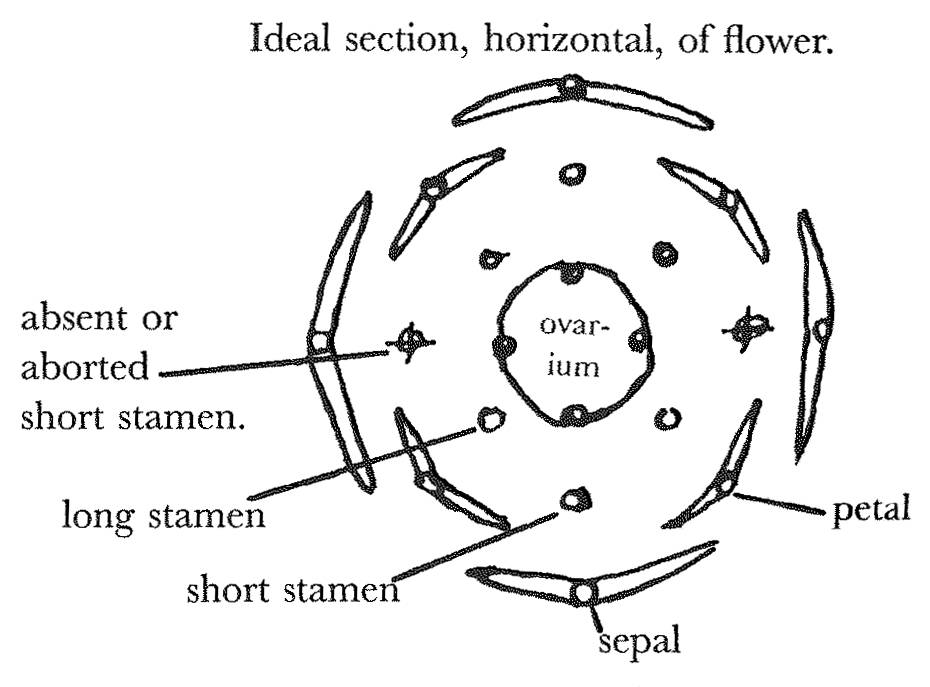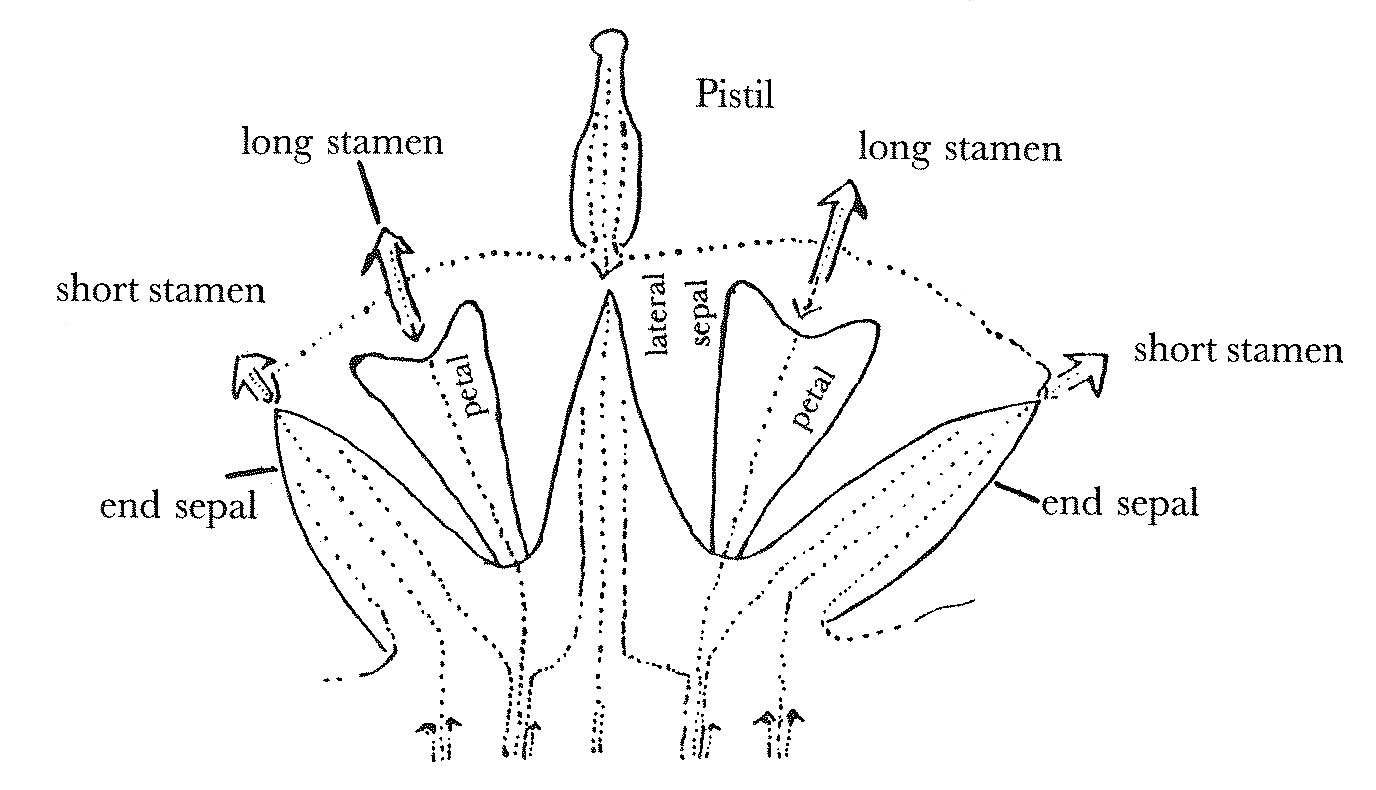To J. D. Hooker 11 September [1862]
Cliff Cottage Bournemouth
Sept 11.
My dear Hooker
You once told me that cruciferous flowers were anomalous in alternation of parts & had given rise to some theory of dedoublement.1 Having nothing on earth to do here I have dissected all spiral vessels in a flower, & instead of burning my diagrams, I send them to you, you miserable man. But mind I do not want you to send me a discussion, but just some time to say whether my notions are rubbish & then burn the diagrams. It seems to me that all parts alternate beautifully by fours (!) on the hypothesis that two short stamens of outer whorl are aborted; & this view is perhaps supported by there being so few, only two, sub-bundles in the two lateral main bundles, where I imagine two short stamens have aborted; but I suppose there is some valid objection against this notion. The course of the side vessels, (not of the midrib) in the sepals is curious just like my difficulty in Habenaria.2 I am surprised at the 4 vessels in the ovarium. Can this indicate 4 confluent pistils? anyhow they are in right alternating position. The nectary within the base of the shorter stamens seems to cause the end sepals apparently, but not really, to arise beneath the lateral sepals.—
I think you will understand my diagrams in five minutes, so forgive me for bothering you. My writing this to you, reminds me of a letter which I received yesterday from Claparède, who helped the French Translatress of the Origin, & he tells me he had difficulty in preventing her (who never looked at a bee-cell) from altering my whole description, because she affirmed that an hexagonal prism must have an hexagonal base!3 Almost everywhere in Origin, when I express great doubt, she appends a note explaining the difficulty or saying that there is none whatever!! It is really curious to know what conceited people there are in the world, (people for instance after looking at one cruciferous flower, explain their homologies!!!).—
This is a nice, but most barren country & I can find nothing to look at.4 Even the brooks & ponds produce nothing— The country is like Patagonia.— My wife is almost well, thank God, & Leonard is wonderfully improved:5 his kidneys excrete less blood & the albumen decreases. Good God what an illness scarlet-fever is. The Doctor feared rheumatic fever for my wife; but she does not know her risk. It is now all over. I do not know whether you have returned; so I have marked this “not to be forwarded”.—6 I saw in paper the marriage of your niece.7 I heartily hope that you have enjoyed yourself, & that it has done Mrs. Hooker good,8 & that you will return to your work refreshed. Thanks for your note from Scotland, with address of Mann &c &c.—9
I was delighted to see by Lindley’s review that your 1st. vol. of Genera is out.10 I have ordered a copy, for I daresay it will be useful even to me.11 The more I potter over flowers, the more I get delighted with them. I expect we shall return home in 3 weeks.12 | Farewell my dear old friend— | Yours affecy | C. Darwin

The little circles represent the bundles of spiral vessels, actually seen (except the two with X) in their proper position, except that they are all crowded to centre.
Longitudinal section of flower of Crucifer, laid flat open, showing by dotted lines the course of spiral vessels in all the organs.13 Sepals & petals shown on one side alone, with the stamens on one side above, with course of vessels indicated, but not prolonged. Near side of pistil with one spiral vessel cut away.

Footnotes
Bibliography
Correspondence: The correspondence of Charles Darwin. Edited by Frederick Burkhardt et al. 29 vols to date. Cambridge: Cambridge University Press. 1985–.
Marginalia: Charles Darwin’s marginalia. Edited by Mario A. Di Gregorio with the assistance of Nicholas W. Gill. Vol. 1. New York and London: Garland Publishing. 1990.
Orchids: On the various contrivances by which British and foreign orchids are fertilised by insects, and on the good effects of intercrossing. By Charles Darwin. London: John Murray. 1862.
Origin: On the origin of species by means of natural selection, or the preservation of favoured races in the struggle for life. By Charles Darwin. London: John Murray. 1859.
Stearn, William T. 1956. Bentham and Hooker’s Genera plantarum: its history and dates of publication. Journal of the Society for the Bibliography of Natural History 3 (1953–60): 127–32.
Summary
Has passed the time by dissecting flowers of Cruciferae. Sends results, with diagrams, to JDH.
Letter details
- Letter no.
- DCP-LETT-3721
- From
- Charles Robert Darwin
- To
- Joseph Dalton Hooker
- Sent from
- Bournemouth
- Source of text
- DAR 115: 162
- Physical description
- ALS 4pp, 2 diags
Please cite as
Darwin Correspondence Project, “Letter no. 3721,” accessed on 19 April 2024, https://www.darwinproject.ac.uk/letter/?docId=letters/DCP-LETT-3721.xml
Also published in The Correspondence of Charles Darwin, vol. 10


